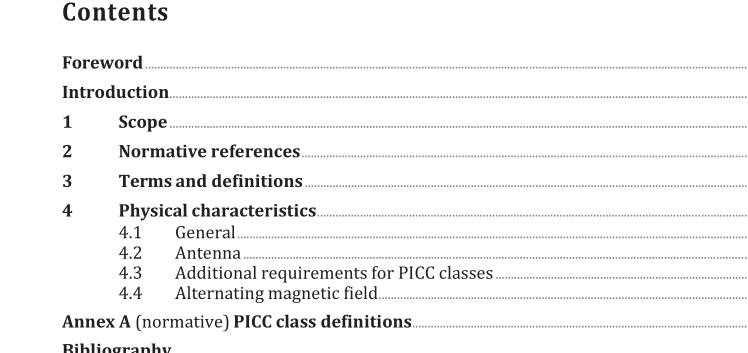ISO IEC 14443-1:2018 pdf download – Cards and security devices for personal identification — Contactless proximity objects — Part 1: Physical characteristics.
1 Scope This document defines the physical characteristics of proximity cards (PICCs). It is intended to be used in conjunction with other parts of ISO/IEC 14443. 2 Normative references The following documents are referred to in the text in such a way that some or all of their content constitutes requirements of this document. For dated references, only the edition cited applies. For undated references, the latest edition of the referenced document (including any amendments) applies. ISO/IEC 7810, Identification cards — Physical characteristics ISO/IEC 14443-2:2016, Identification cards — Contactless integrated circuit cards — Proximity cards — Part 2: Radio frequency power and signal interface ISO/IEC 15457-1, Identification cards — Thin flexible cards — Part 1: Physical characteristics 3 Terms and definitions For the purposes of this document, the terms and definitions given in ISO/IEC 7810, ISO/IEC 15457-1 and the following apply. ISO and IEC maintain terminological databases for use in standardization at the following addresses: — IEC Electropedia: available at http://www.electropedia .org/ — ISO Online browsing platform: available at http://www.iso .org/obp 3.1 integrated circuit IC electronic component designed to perform processing and/or memory functions 3.2 contactless achievement of signal exchange with, and supply of power to, the card without the use of galvanic elements Note 1 to entry: It is also the absence of an ohmic path from the external interfacing equipment to the integrated circuit(s) contained within the card. 3.3 contactless integrated circuit card card into which integrated circuit (3.1) and coupling means have been placed, such that communication to such integrated circuit is done in a contactless (3.2) manner
3.4 operate as intended operates in the manner described by the manufacturer’s specification in accordance with ISO/IEC 14443 3.5 PICC contactless integrated circuit card (3.3) or other object with which communication and power transfer are done by inductive coupling in proximity of a coupling device Note 1 to entry: Commonly called a proximity card. 3.6 PICC antenna zone for each class a zone defined by an external geometrical shape and when defined an internal geometrical shape 3.7 PICC class combination of antenna dimension and loading effect Note 1 to entry: See Annex A . 4 Physical characteristics 4.1 General The PICC may be in the form of a card compliant with ISO/IEC 7810 or ISO/IEC 15457-1, or an object of any other dimension. 4.2 Antenna If the PICC dimensions are not compliant with ISO/IEC 7810 or ISO/IEC 15457-1, the dimensions of the PICC antenna shall not exceed 86 mm × 54 mm × 3 mm. NOTE This antenna size restriction stems from the fact that the radio frequency power and signal interface defined in ISO/IEC 14443-2 and its test methods in ISO/IEC 10373-6 are based on ID-1 cards. 4.3 Additional requirements for PICC classes It has been established that the use of a prescribed PICC class within an industry sector may enhance interoperability within that sector. The use of a PICC class is optional. If used, PICCs shall comply with the requirements given in Annex A . 4.4 Alternating magnetic field If the PICC meets the requirements of one particular class as specified in Annex A , then the PICC, whichever form the PICC has according to 4.1, shall continue to operate as intended after continuous exposure to a magnetic field of an average level of 4/3 times H max at 13,56 MHz as specified in ISO/IEC 14443-2:2016, 6.2 for this class. The averaging time is 30 s and the maximum level of the magnetic field is limited to 8/5 times H max . If the PICC does not claim to meet the requirements of one particular class as specified in Annex A , then the PICC, whichever form the PICC has according to 4.1, shall continue to operate as intended after continuous exposure to a magnetic field of an average level of 10 A/m (rms) at 13,56 MHz. The averaging time is 30 s and the maximum level of the magnetic field is limited to 12 A/m (rms).
ISO IEC 14443-1:2018 pdf download – Cards and security devices for personal identification — Contactless proximity objects — Part 1: Physical characteristics






